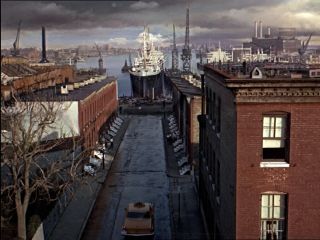The MacGuffin: News and Comment (22/Mar/2008)
(c) Ken Mogg (2008)
March 22
The great production designer and art director Robert Boyle, aged 98, recently received a special Academy Award for his work in films, not least several for Alfred Hitchcock. Now someone has sent me a DVD copy of the 40-minute documentary called The Man on Lincoln's Nose, directed by Daniel Raim and originally released in 2000 - but recently updated (I gather). The main thing is, it's lovingly made and nicely informative, and I would like to discuss it here. (To see a brief trailer for the film, paste the folowing URL into your browser: http://www.lincolnsnose.com/) Naturally I paid particular attention to what Boyle - who appears throughout the documentary - has to say about the films he did with Hitchcock, starting with Saboteur (1942) and culminating in Marnie (1964). But in fact something that first caught my ear was Boyle's remark that he originally worked with a man named (Henry) MacRae on Universal serials like Don Winslow of the Navy (1942). In my book on Hitchcock, I note the little-known fact that some of the music in Saboteur is taken from that very serial. About Saboteur itself, Boyle is lucid, drawing for us lessons about creating suspense based in ordinary human experience. For example, he cites the scene where Barry (Robert Cummings) arrives at the hermit's cabin in the forest. It is raining, and the fugitive Barry is hungry - obvious, if partly inadvertent, foreshadowings of Psycho - and throws himself on the goodwill and hospitality of the cabin's occupant, Phillip Martin (Vaughan Glaser), who turns out to be blind. Nothing much happens, except that we feel strongly the scene's humanity. This is in keeping with what Hitchcock once told Boyle about the importance of 'penultimate moments', that is, the moments leading up to some incident or action. In this case, the warmth Barry feels in the cabin (in two senses) preceeds the moment when Phillip's daughter Patricia (Priscilla Lane) arrives and suddenly, with a small gasp, notices the handcuffs dangling from Barry's wrist. (Another important 'penultimate moment' in Hitchcock, cited by Boyle, is the conversation at the prairie crossroads in North by Northwest between another fugitive, Roger Thornhill, and the man waiting for the bus. As soon as the man has boarded his bus and disappeared into the distance, Roger finds himself being attacked by a crop-dusting plane armed with a machine-gun!) Boyle notes the importance of minimal distraction. 'The flashier aspects of making a fine-looking set', he notes, are often the last thing on your mind when designing films for Hitchcock, who mainly wanted the audience to be able to identify with the hero or heroine. Suitably, Boyle's reputation was for 'scrupulously detailed' sets and 'absolutely appropriate' touches (as fellow production designer James D. Bissell tells us). On Norman Jewison's period films Gaily, Gaily (1969), set in old Chicago, and Fiddler on the Roof (1971), set in the old Ukraine, Boyle was meticulous and brilliant. Planning the latter film, he boarded a plane with Jewison to choose filming sites in Europe. (Boyle, whom Jewison calls 'a charming Irishman', had a Jewish wife, so he was probably already familiar with Sholom Aleichem's story in particular - and certainly with Jewish culture in general.) They travelled widely to towns and villages - including in Rumania, Hungary, and Israel - looking for the most suitable spot to film. Amusingly, Boyle remembers how, wherever they went, they took with them a tape of the show's musical numbers. After arriving in each prospective location, they would play the tape and, if the music didn't seem to fit, would quickly move on. One small thing troubled me in the documentary, and that was Boyle's discussion of his work on Marnie. At one point, Boyle and cinematographer Robert Burks went to Hitchcock and said that they would like to re-shoot the scenes with the ship at the end of Mrs Edgar's street. But Hitchcock replied, 'I don't see anything wrong with [the look of] the ship, Bob.' So the scenes stayed as they were. Boyle cites the critical storm that blew up after the film's release about just those scenes, and the backdrop of the ship in particular, and we are left with the impression that the director had made an error. I can't accept that - it was the critics who were wrong. The whole discussion of this matter in the documentary is simplified. In particular, no mention is made of how the initial high-shot of the street is clearly not one that used the controversial backdrop but consists of an absolutely beautiful painting by gifted matte artist Albert Whitlock, with Marnie's arrival by taxi matted into the middle-distance. (See frame-capture below.) As for Boyle's backdrop (whether or not the problem concerned its supposedly phoney look in general or whether the problem was more about how light glinted from the backdrop at a certain angle), the effect was still highly apt, inasmuch as it concerned the symbolism of Marnie's shut-in world and that of her no-less psychologically damaged mother - whose side of the street never gets the sun, notice. But Boyle should have the last word here. Ironically, he talks near the end of this fine documentary about how set designers are artists. '[We should] try to get back to the essence, which children instinctively know.' Films these days 'are too concerned with climaxes [rather than penultimate moments]'.
This material is copyright of Ken Mogg and the Hitchcock Scholars/'MacGuffin' website (home page) and is archived with the permission of the copyright holder. |

